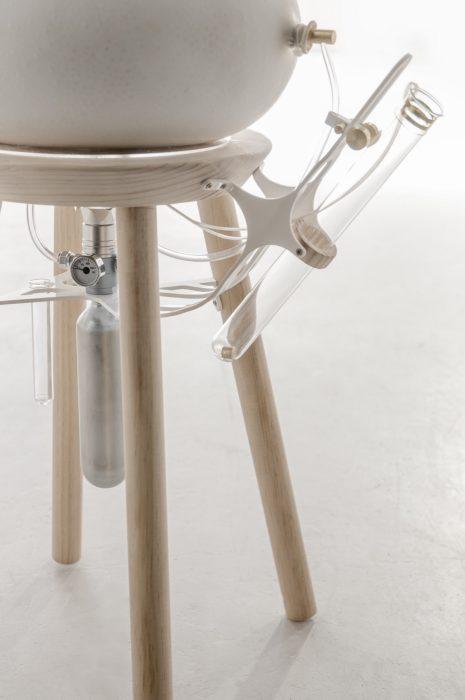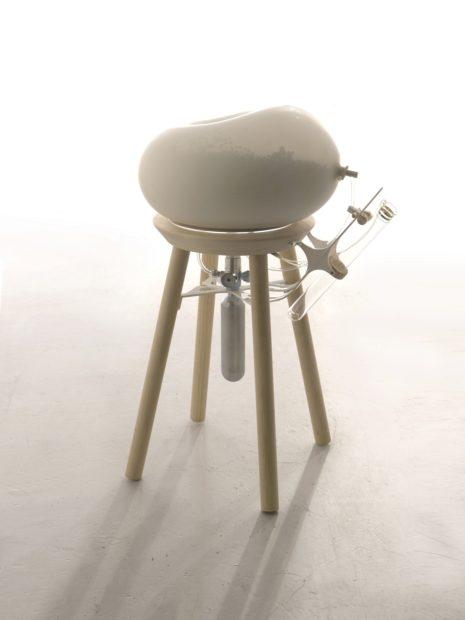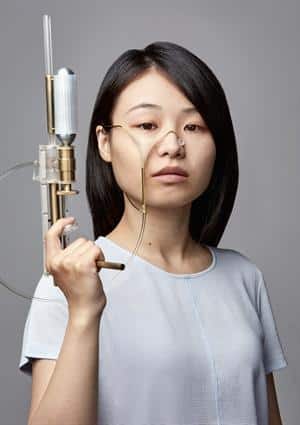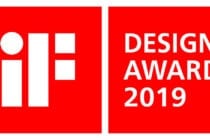At Dutch Design Week 2017, the young Taiwanese designer Yi Fei Chen presented a stool that is supposed to save people from embarrassing or awkward situations. The cultural background of Fei explains why such a piece of furniture can be useful when – for cultural reasons – you cannot simply say “No!” or just want to be left alone for a while.
The sense and purpose of a teargun also emerges from the asian cultural context: where social conventions dictate that feelings should be hidden behind a smile, the teargun seems like poetry cast in smart technology.
Therefore Fei created her own kind of ‘cigarette’. Like a cigarette, her tool helps to escape from awkward social situations. She created a unique stool as a means to get an acceptable excuse for a short break and come back later.
“The cushion will slowly inflate when sitting down. The increasing inflation represents the increasing social pressure and it also reflects the intensified emotions that will soon reach their limit: the person on the seat might expect it to explode. Fortunately the cushion can be deflated by feeding water from the side. Therefore, it is a good reason to excuse yourself to get some water for the chair. The challenge of taking care of this chair is to obtain the optimal balance between sitting, leaving and feeding.”
The stool is a metaphor for the camouflaged excuse to limit the time of social interactions. It visualises the hidden need of the person sitting on it for a break.
DESIGNBOTE editor Wolfgang Linneweber talked with the Design Academy Eindhoven graduate:
Your objects – or are they ‘products’?- sparkle with humour and show multiple layers of meaning.
“That depends on how you define product. For my definition, yes, it is a product for sure. Even though it is not a comfortable or really cozy stool to for the customer, but the more it can evolve into peoples daily life, the more chance to trigger different thoughts and convey my message.(it is in the next answer.)”
As a surplus they trigger and transport contradictional feelings (not only) in me. What is the source of such ideas?
“(I would love to know what kind of contra-dictional feelings trigger you.)
There are a lot of cultural differences, even though we can learn from internet, for example, we know asian are polite, but what is polite mean to you, as a German, in what way? How asian being polite? because there are also diverse of the definitions of politeness. And to explain this, i will tell you a story.
I have always been envying those who smoke for the reason that I discovered cigarette as a very useful tool in a social context. It enables the smoker to take a break and to leave the current, possibly unpleasant situation without revealing the real excuse underlying the action of craving for a cigarette. To me this is a very good excuse to leave an uncomfortable moment.
A few years ago, when I just arrived in The Netherlands, I went to some gatherings and saw some friends taking cigarettes out of their pockets and having a break outside. At the same time I felt that I need some fresh air, and therefore I went outside and took a small walk on my own. When I came back everyone looked at me and asked me if I would be alright. At that brief moment I felt the pressure to tell the truth. In fact, I just wanted to be on my own for a bit. Nevertheless, in this case I kept my feelings and chose not to speak out to prevent the unnecessary attention or care—so I immediately made up an excuse, because I think that is more gentle and polite.
Since in the Taiwanese culture, we usually don’t directly tell an ordinary friend: “Sorry, I want to be alone”. This message is often used in serious and negative contexts. However, this doesn’t mean that we don’t need a break at all, but we just have a different way of sending messages. Codes like “I need to make a phone call” or “I need to go to the ATM” are more likely realistic excuses. Even though we use this secret language, everybody is able to read between the lines.
But it is always a bit hard to explain to my european friends, and also I felt a lot of un-fit in western social occasion, so the first idea is “I want make my own cigarette(an escaping tool)”. Moreover, we are really creative of making different excuse in different context, to different person, why not make “excuse” alive? Like an animal. ( Because non-living object wont be so flexible and smart. It is also very east asian thinking, we try to adapt the environment, not asking others to change.) And I want to see what it would be look like and how it will act.”
Do you intend to make your social environment the stage for your version of ‘social art’?
Maybe the tear-gun actually refers to something quite different and less obvious than just shooting frozen tears?
“Yes, there are a lot of layers behind it.”
How come that the emotional effects your ‘products’ base on and play with seem to circle round awkwardness (in a strange surrounding)?
“Because training as a product designer in my bachelor, we had been taught that design is to solve problems. And what bothers me most is social situations. Which I want to use my skill to solve these.”
Do they reflect your personal experiences?
“Yes, i got inspired by my personal struggles and problems which i don’t see obvious solutions.”
My feeling: on the first sight the dutch society is very tolerant and open (maybe an echo of the roaring seventies) while nowadays everything runs like on rails and there are lots of tacid social agreements one has to comply. but from a german point of view is guess that germany is just anarchic compared to contemporary holland. How strange do the Netherlands feel to you as hailing from quite a different culture?
“Totally different mindsets. Especially I learn some new concepts which you don’t talk often in east Asia culture (such as personal boundaries, and i think that is why we have some problem to say no. We have different way to achieve it, just like i mentioned that we sometimes give a excuse to reject something or put distance and others know the “code”.)”
Did you ever feel alienated so far from home? If so, did that very feeling feed / shape any creative solution or product you created?
“Yes. That makes me be aware of the culture differences which i never notice when I were in Taiwan, also my pattern of behaviour, which helps me to know myself better.”
“Yes.”
Which reactions did you trigger when presenting the stool and tear gun publicly?
“The mentor is quit nervous ( maybe scared ) when I pointed a gun on him. (which he has no idea how strong it would be). Suspension.”
You work in the periphery of engeneering and you seem to have a weak spot for gas- and fluid operated technology. How come?
“I am happy that you notice that, and that is interesting for me that you think in that way. Actually I have another stool prototype work (previous version) which is the concept but work with fire and needle. But this (new) version I kind of choose the same technic with tear gun because I want to make connection and build my visual language. In other words, I left some hint for the audience, and it really works, some design students and one journalism recognised it and talked to me if i am the designer of tear gun.”
Which production techniques did you apply for your stool and tear gun?
“Metal lathe work, wood work, mechanics, silicon moulding, pneumatic system.”
Where do you plan to implement your skills after your graduation?
“I am very into machines and devices.”
Fei, thanks for your time!
Stool: ‘excuse me’
Yi Fei Chen with tear-gun:











0 Kommentare